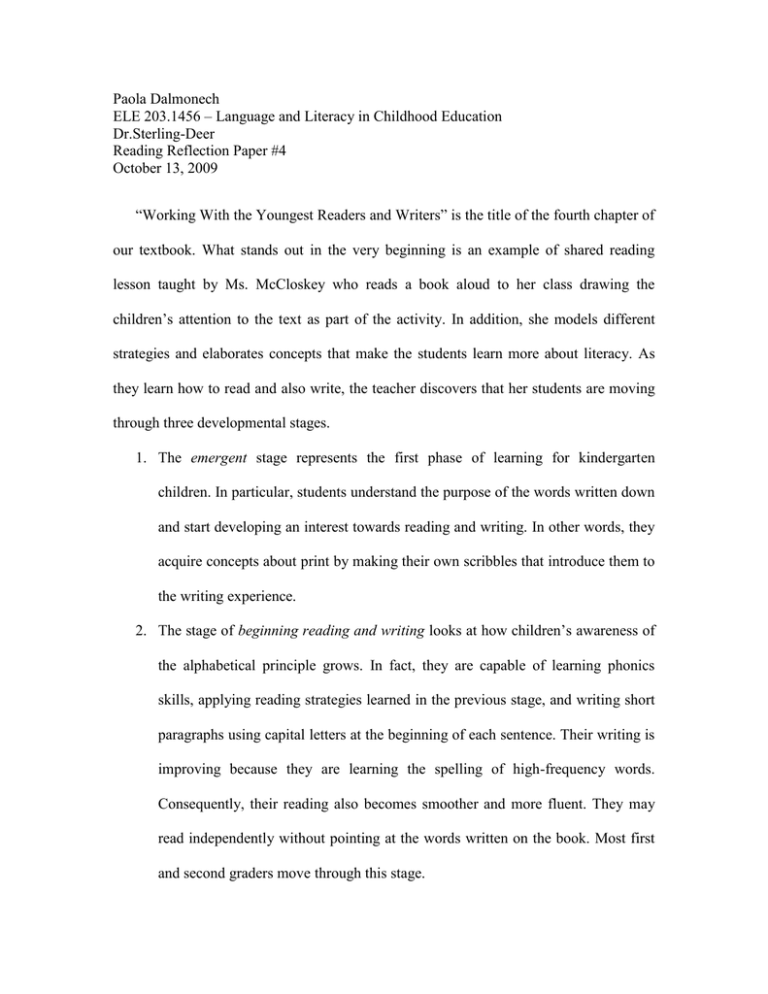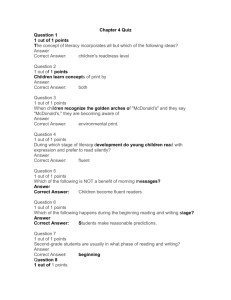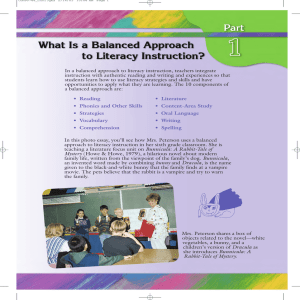Paola Dalmonech ELE 203.1456 – Language and Literacy in Childhood Education Dr.Sterling-Deer
advertisement

Paola Dalmonech ELE 203.1456 – Language and Literacy in Childhood Education Dr.Sterling-Deer Reading Reflection Paper #4 October 13, 2009 “Working With the Youngest Readers and Writers” is the title of the fourth chapter of our textbook. What stands out in the very beginning is an example of shared reading lesson taught by Ms. McCloskey who reads a book aloud to her class drawing the children’s attention to the text as part of the activity. In addition, she models different strategies and elaborates concepts that make the students learn more about literacy. As they learn how to read and also write, the teacher discovers that her students are moving through three developmental stages. 1. The emergent stage represents the first phase of learning for kindergarten children. In particular, students understand the purpose of the words written down and start developing an interest towards reading and writing. In other words, they acquire concepts about print by making their own scribbles that introduce them to the writing experience. 2. The stage of beginning reading and writing looks at how children’s awareness of the alphabetical principle grows. In fact, they are capable of learning phonics skills, applying reading strategies learned in the previous stage, and writing short paragraphs using capital letters at the beginning of each sentence. Their writing is improving because they are learning the spelling of high-frequency words. Consequently, their reading also becomes smoother and more fluent. They may read independently without pointing at the words written on the book. Most first and second graders move through this stage. 3. Fluent Reading and Writing. This stage marks children’s move into fluent reading and writing. Students whose reading is fluent, rapid and expressive belong here. They read words accurately using decoding and comprehension strategies effectively. Most fluent readers prefer reading silently; they are able to read for a longer period staying focused, and they may pick more complex books. In terms of writing, their ability also enhanced; their compositions are longer and better thought because they are familiar with the writing process stages. When working with young readers and writers, a list of instructional practices is embedded. In the previous reading reflection papers we discussed about reading aloud to children, doing guided reading, teaching from basal reading textbooks, and providing opportunities for independent reading and writing in reading and writing workshop. However, these are not the only ones. For example, teachers use very often the morning message, which is a brief message that reports what will happen during the day. In this way, students get used to picking out words and letters and becoming more confident with them. Language Experience Approach is another approach for teaching literacy in the sense that is based on children’s language and experiences. The procedure is the following: children dictate words and sentences that are related to their personal experiences, and the teacher writes them down. By doing this, students are going to visualize what they said; the text they developed becomes the reading material. Furthermore, the book describes what interactive writing is. In other words, children create and compose a message, and then the teacher helps them write it on chart paper. The teacher functions as a guide for the children, especially when they are learning concepts about print. What I think deserves high consideration and comment is the part of this chapter that explores children learning the concepts about print. I think it is very important that young children are introduced to written language before they begin school, and this is the parents’ task in fostering their children’ interest towards literacy. Young children start reading by recognizing environmental printed inscriptions in their community. With experience, they become more proficient and want to know what those words mean. Thus, in school children learn about the purposes of reading and writing as they use written language even in play centers, where teachers add literacy material with the scope of enriching their value for literacy learning. After learning concepts about print, students are brought to the discovery of words as labels for things, and eventually they will develop concepts about the alphabet and how letters are used to represent phonemes. Every single activity is provided by the teachers whose intent is to make children enjoy and increase their interest towards reading and writing.



